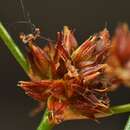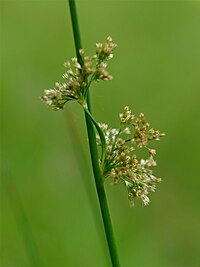Associations
provided by BioImages, the virtual fieldguide, UK
Foodplant / sap sucker
adult of Agramma laetum sucks sap of Juncus
Remarks: Other: uncertain
In Great Britain and/or Ireland:
Plant / associate
fruitbody of Agrocybe paludosa is associated with Juncus
Foodplant / feeds on
larva of Aphanisticus emarginatus feeds on Juncus
Foodplant / feeds on
larva of Aphanisticus pusillus feeds on Juncus
Foodplant / feeds on
larva of Bagous lutulosus feeds on Juncus
Foodplant / saprobe
apothecium of Belonopsis iridis is saprobic on dead stem of Juncus
Remarks: season: 6
Foodplant / saprobe
sessile apothecium of Belonopsis juncicola is saprobic on dead culm of Juncus
Remarks: season: 8
Foodplant / saprobe
apothecium of Belonopsis junciseda is saprobic on dead Juncus
Plant / resting place / on
larva of Bolothrips dentipes may be found on base of Juncus
Remarks: season: 7-9
Foodplant / saprobe
basidiome of Cellypha goldbachii is saprobic on dead leaf of Juncus
Foodplant / saprobe
slender-stalked apothecium of Ciboria juncorum is saprobic on fallen fruit of Juncus
Remarks: season: 6
Foodplant / saprobe
fruitbody of Clitopilus hobsonii is saprobic on dead, decayed debris of Juncus
Other: minor host/prey
Foodplant / saprobe
fruitbody of Coniophora prasinoides is saprobic on old, dead stem of Juncus
Foodplant / saprobe
fruitbody of Coprinopsis friesii is saprobic on decayed culm of Juncus
Foodplant / saprobe
fruitbody of Coprinopsis martinii is saprobic on decayed debris of Juncus
Foodplant / saprobe
often buried under desne layers of decayed grass leaves fruitbody of Coprinopsis urticicola is saprobic on decayed debris of Juncus
Remarks: season: summer
Foodplant / sap sucker
adult of Cymus melanocephalus sucks sap of Juncus
Plant / associate
Cyrtorhinus caricis is associated with base of clump of Juncus
Foodplant / feeds on
Discula coelomycetous anamorph of Discula junci feeds on Juncus
Foodplant / open feeder
larva of Dolerus ferrugatus grazes on leaf of Juncus
Other: sole host/prey
Foodplant / open feeder
larva of Dolerus madidus grazes on leaf of Juncus
Other: sole host/prey
Foodplant / open feeder
larva of Dolerus triplicatus grazes on leaf of Juncus
Other: sole host/prey
Foodplant / saprobe
pycnidium of Ascochyta coelomycetous anamorph of Eriospora leucostoma is saprobic on dead leaf of Juncus
Remarks: season: 2-4
Foodplant / sap sucker
adult of Eurygaster testudinaria sucks sap of Juncus
Other: major host/prey
Plant / grows among
fruitbody of Galerina jaapii grows among Juncus
Foodplant / saprobe
apothecium of Gorgoniceps micrometra is saprobic on dead leaf of Juncus
Remarks: season: 4
Plant / resting place / on
adult of Haplothrips juncorum may be found on live flower of Juncus
Remarks: season: 6-9
Foodplant / saprobe
fruitbody of Hemimycena delectabilis is saprobic on dead leaf of Juncus
Other: major host/prey
Plant / associate
fruitbody of Hygrophoropsis fuscosquamula is associated with Juncus
Plant / associate
fruitbody of Hygrophoropsis macrospora is associated with Juncus
Plant / associate
fruitbody of Hypholoma myosotis is associated with Juncus
Foodplant / saprobe
superficial stroma of Hypocrea spinulosa is saprobic on decaying stem of Juncus
Remarks: season: 8-11
Other: minor host/prey
Foodplant / saprobe
immersed, then revealed apothecium of Hysteropezizella rehmii is saprobic on dead Juncus
Foodplant / saprobe
fruitbody of Jaapia argillacea is saprobic on decayed, dead leaf of Juncus
Foodplant / feeds on
larva of Kateretes rufilabris feeds on Juncus
Foodplant / parasite
Ligniera junci parasitises live root hair of Juncus
Foodplant / gall
Livia juncorum causes gall of flower shoot of Juncus
Fungus / saprobe
numerous, often confluent pycnothyrium of Actinothyrium coelomycetous anamorph of Lophodermium apiculatum is saprobic on dead Juncus
Remarks: season: 3-8
Other: minor host/prey
Foodplant / saprobe
superficial perithecium of Loramyces juncicola is saprobic on dead stem of Juncus
Foodplant / saprobe
fruitbody of Marasmiellus candidus is saprobic on dead litter of Juncus
Foodplant / saprobe
fruitbody of Marasmiellus vaillantii is saprobic on debris of Juncus
Foodplant / saprobe
fruitbody of Marasmius limosus is saprobic on dead, decaying leaf of Juncus
Other: unusual host/prey
Foodplant / feeds on
Mecomma ambulans feeds on Juncus
Foodplant / saprobe
fruitbody of Melanotus phillipsii is saprobic on dead, decayed debris of Juncus
Foodplant / saprobe
thyriothecium of Morenoina fimbriata is saprobic on dead stem of Juncus
Remarks: season: mainly 5
Foodplant / saprobe
thyriothecium of Morenoina minuta is saprobic on dead stem of Juncus
Remarks: season: mainly 5
Foodplant / saprobe
thyriothecium of Morenoina paludosa is saprobic on dead stem of Juncus
Remarks: season: mainly 5
Foodplant / saprobe
fruitbody of Mycena bulbosa is saprobic on dead, decayed, wet debris of Juncus
Other: major host/prey
Foodplant / saprobe
fruitbody of Mycocalia minutissima is saprobic on dead, fallen, decaying, wet leaf of Juncus
Foodplant / saprobe
fruitbody of Mycocalia sphagneti is saprobic on dead culm of Juncus
Foodplant / saprobe
pseudothecium of Mycosphaerella recutita is saprobic on Juncus
Foodplant / saprobe
stalked sporodochium of Myrothecium dematiaceous anamorph of Myrothecium masonii is saprobic on Juncus
Foodplant / saprobe
sessile apothecium of Nimbomollisia eriophori is saprobic on dead leaf of Juncus
Remarks: season: 6-10
Foodplant / saprobe
apothecium of Niptera pulla is saprobic on dead Juncus
Remarks: season: 3-5
Plant / associate
fruitbody of Omphalina mutila is associated with dead, decayed debris of Juncus
Foodplant / saprobe
effuse colony of Chaetochalara dematiaceous anamorph of Phaeoscypha cladii is saprobic on Juncus
Foodplant / saprobe
superficial conidioma of Dinemasporium coelomycetous anamorph of Phomatospora dinemasporium is saprobic on dead leaf of Juncus
Remarks: season: 1-12
Foodplant / saprobe
fruitbody of Pterula caricis-pendulae is saprobic on wet, dead, decayed debris of Juncus
Foodplant / saprobe
fruitbody of Pterula debilis is saprobic on dead stem of Juncus
Foodplant / saprobe
fruitbody of Resinomycena saccharifera is saprobic on dead, decayed debris of Juncus
Plant / associate
Thryogenes nereis is associated with Juncus
Plant / resting place / on
fruitbody of Tomentella ferruginea may be found on dead, decayed debris of Juncus
Other: unusual host/prey
Plant / resting place / on
fruitbody of Tomentella radiosa may be found on dead, decayed debris of Juncus
Other: unusual host/prey
Foodplant / saprobe
fruitbody of Trechispora minima is saprobic on dead, decayed debris of Juncus
Foodplant / saprobe
fruitbody of Typhula quisquiliaris is saprobic on dead, decayed culm of Juncus
Other: unusual host/prey
Description
provided by Flora of Zimbabwe
Glabrous herbs, generally occurring in wet places. Leaves flat or cylindric, sometimes
septate. Inflorescence compound, paniculate, bracteate; bracteoles
sometimes present immediately below and clasping the flower. Perianth
segments free, ovate or lanceolate, entire, persistent.
- license
- cc-by-nc
- copyright
- Mark Hyde, Bart Wursten and Petra Ballings
- bibliographic citation
- Hyde, M.A., Wursten, B.T. and Ballings, P. (2002-2014). Juncus Flora of Zimbabwe website. Accessed 28 August 2014 at http://www.zimbabweflora.co.zw/speciesdata/genus.php?genus_id=325
- author
- Mark Hyde
- author
- Bart Wursten
- author
- Petra Ballings
Juncus: Brief Summary
provided by wikipedia EN
Juncus is a genus of monocotyledonous flowering plants, commonly known as rushes. It is the largest genus in the family Juncaceae, containing around 300 species.
- license
- cc-by-sa-3.0
- copyright
- Wikipedia authors and editors


